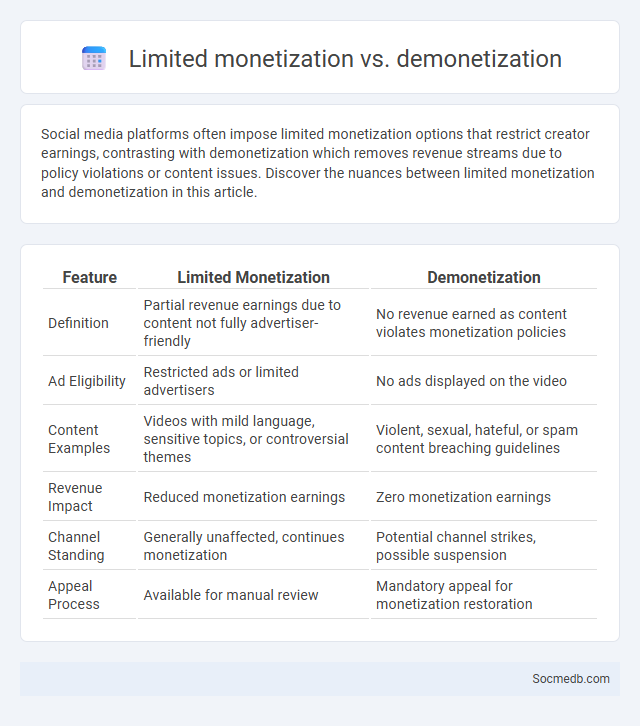
Photo illustration: Limited monetization vs Demonetization
Social media platforms often impose limited monetization options that restrict creator earnings, contrasting with demonetization which removes revenue streams due to policy violations or content issues. Discover the nuances between limited monetization and demonetization in this article.
Table of Comparison
| Feature | Limited Monetization | Demonetization |
|---|---|---|
| Definition | Partial revenue earnings due to content not fully advertiser-friendly | No revenue earned as content violates monetization policies |
| Ad Eligibility | Restricted ads or limited advertisers | No ads displayed on the video |
| Content Examples | Videos with mild language, sensitive topics, or controversial themes | Violent, sexual, hateful, or spam content breaching guidelines |
| Revenue Impact | Reduced monetization earnings | Zero monetization earnings |
| Channel Standing | Generally unaffected, continues monetization | Potential channel strikes, possible suspension |
| Appeal Process | Available for manual review | Mandatory appeal for monetization restoration |
Understanding Limited Monetization: Definition and Context
Limited monetization refers to the restricted ability of content creators and social media users to generate revenue from their posts, videos, or live streams due to platform policies, audience size, or content type. Social media platforms like YouTube, Instagram, and TikTok impose eligibility criteria, such as follower count and engagement metrics, which can limit monetization opportunities for smaller creators or those producing niche content. This context shapes how influencers strategize content creation and audience engagement to meet platform standards and maximize earning potential within constraints.
What is Demonetization? Key Features and Impacts
Demonetization on social media refers to the removal or limitation of monetization features, like ads or paid content, on user-generated content that violates platform policies or community guidelines. Key features include restrictions on ad revenue, disabling of sponsored content, and limited access to monetization tools for affected creators. The impacts involve reduced income for content creators, decreased content diversity, and shifts in platform engagement strategies to prioritize advertiser-friendly material.
Limited Monetization vs Demonetization: Core Differences
Limited monetization on social media allows content creators to earn revenue with certain restrictions or reduced ads, often due to guidelines that partially limit advertiser-friendly content. Demonetization refers to the complete removal of monetization privileges, preventing creators from earning any revenue from their content until issues are resolved. Understanding these core differences helps creators navigate platform policies, optimize content strategy, and maintain compliance with advertising standards.
How Limited Monetization Affects Content Creators
Limited monetization options significantly restrict content creators' ability to generate sustainable income from their social media efforts. This financial constraint often forces creators to reduce content quality or frequency, hindering audience growth and engagement. Platforms with transparent, diverse monetization models typically see higher creator retention and more innovative content development.
The Effects of Demonetization on Revenue Streams
Demonetization on social media platforms significantly disrupts revenue streams by limiting ad placements and reducing influencer earnings, directly impacting content creators and advertisers. Platforms like YouTube and Instagram experience fluctuations in ad revenue and brand sponsorship deals, as stricter monetization policies curtail income potential. This shift forces creators to explore alternative income models such as crowdfunding, merchandise sales, and exclusive subscription services to sustain their digital presence.
Limited Monetization: Causes and Common Triggers
Limited monetization on social media often results from algorithm changes, low engagement rates, or violations of platform policies. Advertiser preferences and audience demographics significantly impact your revenue potential and content visibility. Understanding these triggers helps optimize content strategies to improve monetization opportunities effectively.
Demonetization Case Studies: Platform Policies in Action
Social media platforms enforce stringent demonetization policies to regulate content that violates community guidelines or federal regulations, impacting creators' revenue streams. Your awareness of these platform-specific rules, such as YouTube's advertiser-friendly content guidelines and Facebook's brand safety measures, is crucial to maintaining monetization eligibility. Case studies from TikTok and Instagram demonstrate how automated algorithms and human review processes work together to identify and demonetize inappropriate or controversial content efficiently.
Navigating Monetization Limits: Best Practices for Creators
Creators face monetization limits across platforms like Instagram, YouTube, and TikTok, requiring strategic content diversification and audience engagement. Leveraging multiple revenue streams such as brand partnerships, merchandise sales, and fan subscriptions enhances earning potential despite algorithmic constraints. Consistent analysis of platform policies and adapting content to meet compliance standards ensures sustainable income growth in the competitive social media landscape.
Reversing Limited Monetization and Demonetization: Possible Solutions
Limited monetization and demonetization on social media platforms can be addressed by implementing transparent algorithmic guidelines that ensure content creators understand the criteria for income eligibility. Introducing diversified revenue streams such as direct subscriptions, merchandise sales, and fan-driven funding enhances financial stability for influencers and small creators. Platforms adopting fair appeal processes and providing real-time analytics empower creators to optimize content while mitigating risks of sudden income loss.
Future Trends in Monetization and Demonetization Policies
Social media platforms are increasingly adopting advanced monetization strategies such as subscription models, creator funds, and integrated e-commerce features to enhance revenue streams. Emerging trends also highlight stricter demonetization policies targeting misinformation, harmful content, and copyright violations to ensure platform integrity and advertiser safety. Data-driven algorithms and AI tools are playing a critical role in balancing user engagement with policy enforcement to sustain long-term platform growth.
 socmedb.com
socmedb.com